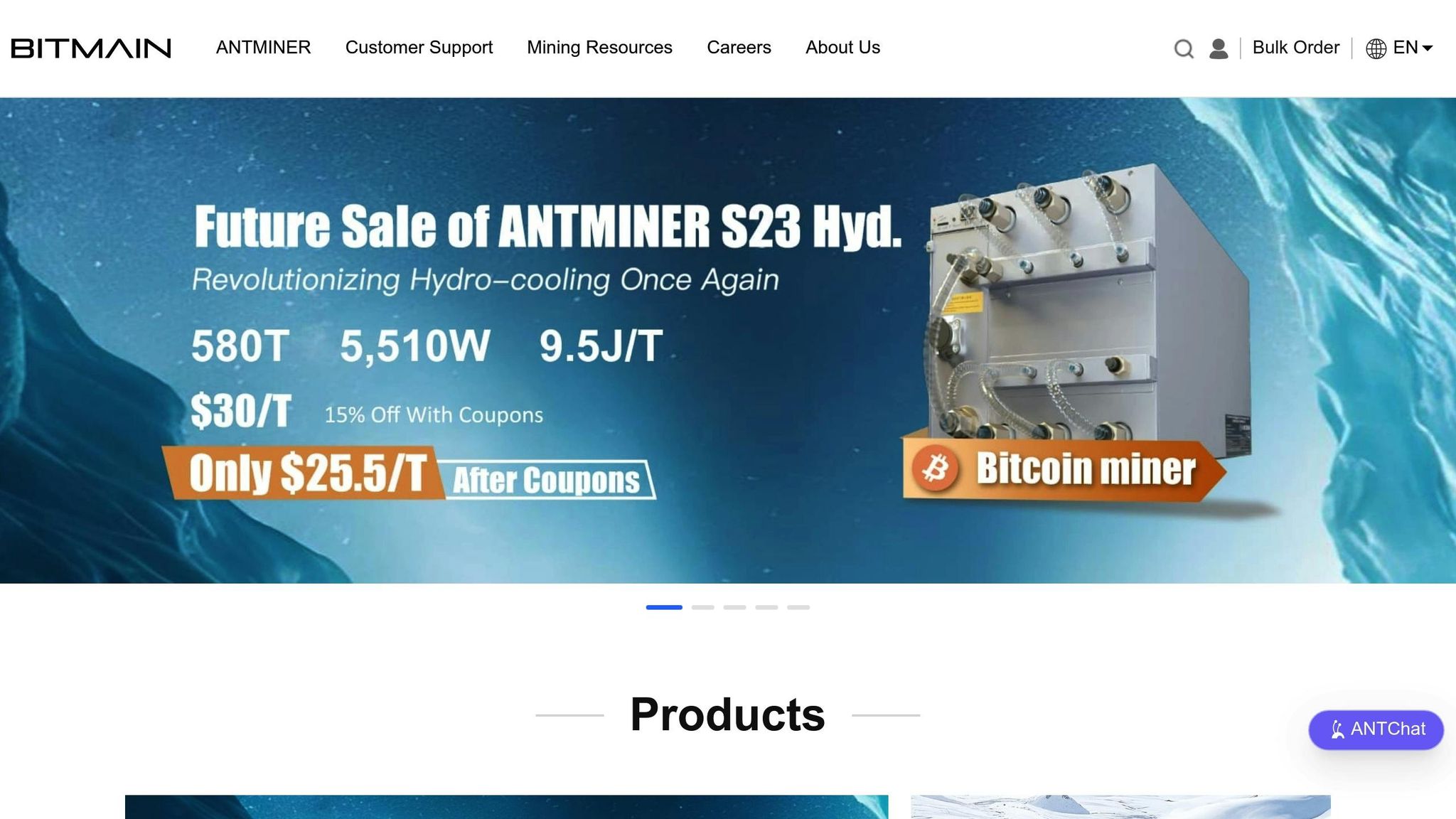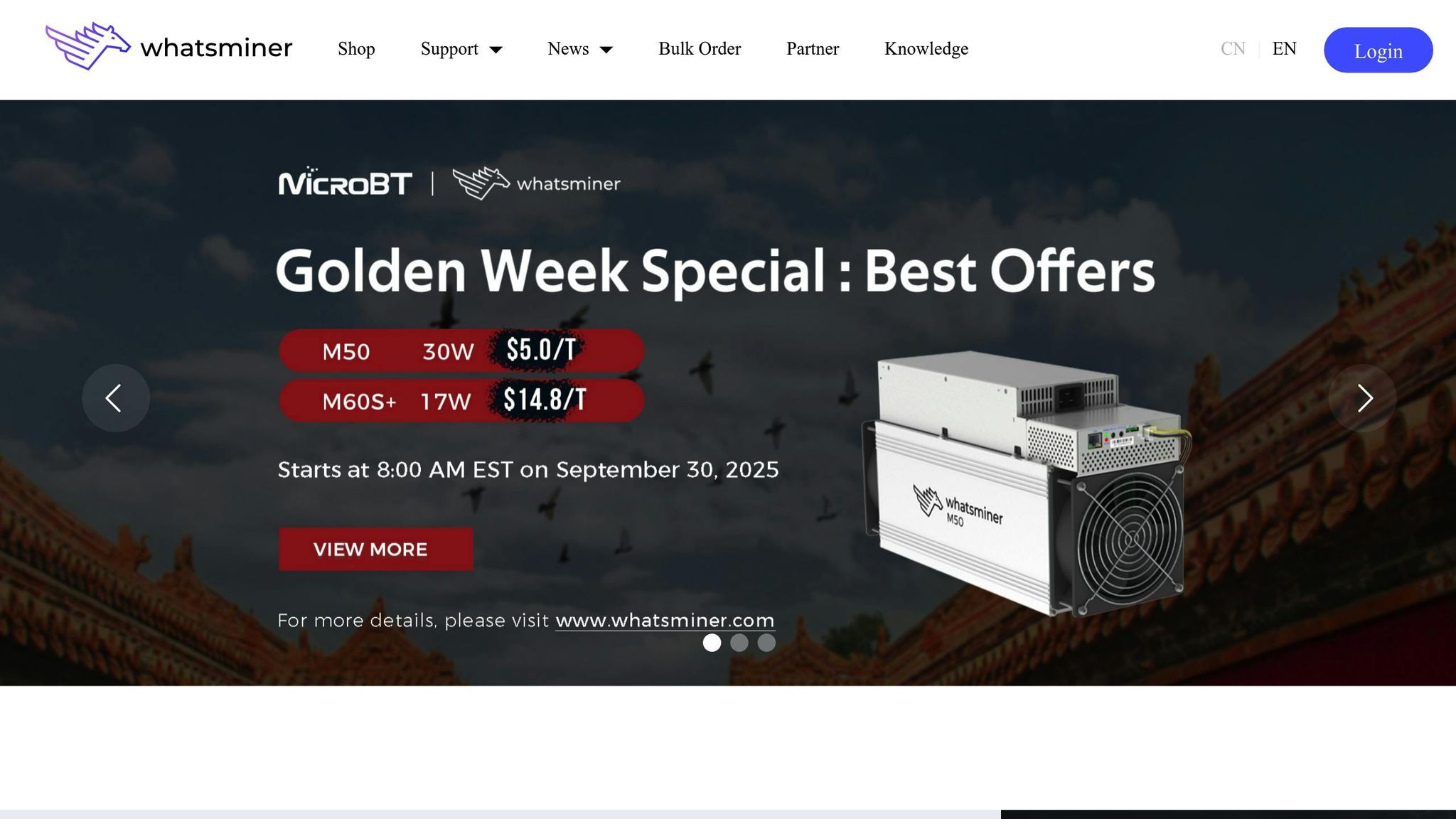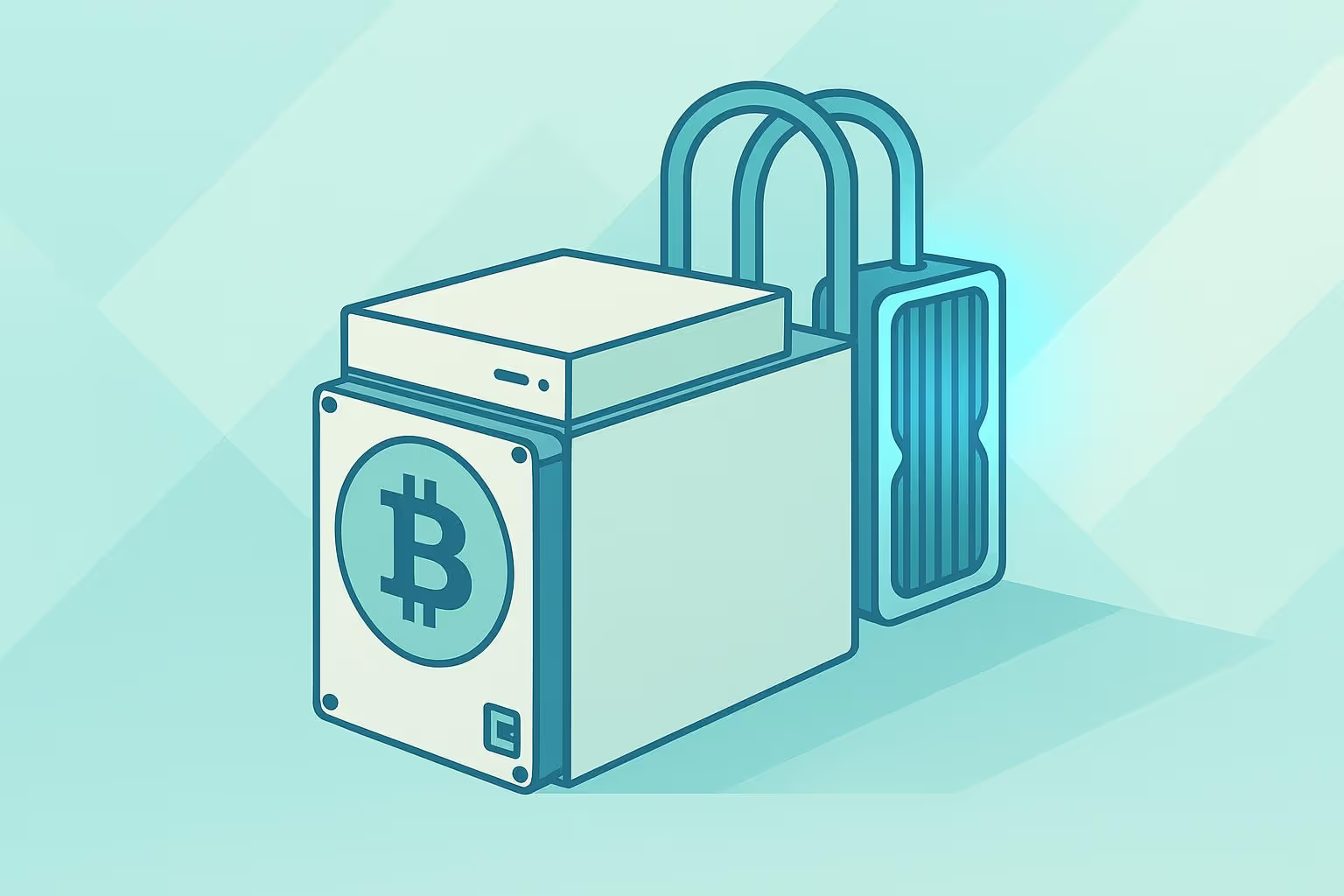The Bitmain S19 XP Hydro offers Bitcoin miners a liquid-cooled ASIC rig with energy efficiency of 20.8 J/TH and power consumption between 5,304 W and 5,345 W. It comes in two models: 246 TH/s and 257 TH/s, priced at $3,847 and $3,997, respectively. Both models are hosted in Paraguay using 100% hydropower, with monthly hosting fees of $239 and $250.
Meanwhile, the WhatsMiner M63S provides higher performance with 370 TH/s and 402 TH/s models, operating at a more efficient 18.5 J/TH. These rigs are hosted in Norway, powered by 99% carbon-free energy, and priced at $11,837 and $12,937, with monthly hosting fees of $230 and $250.
Quick Comparison
| Model | Hashrate | Efficiency | Price | Monthly Hosting | Energy Source | Performance Guarantee |
|---|---|---|---|---|---|---|
| Bitmain S19 XP Hydro (246 TH/s) | 246 TH/s | 20.8 J/TH | $3,847 | $239 | 100% hydropower | 90% annual |
| Bitmain S19 XP Hydro (257 TH/s) | 257 TH/s | 20.8 J/TH | $3,997 | $250 | 100% hydropower | 90% annual |
| WhatsMiner M63S (370 TH/s) | 370 TH/s | 18.5 J/TH | $11,837 | $230 | 99% carbon-free | 95% annual |
| WhatsMiner M63S (402 TH/s) | 402 TH/s | 18.5 J/TH | $12,937 | $250 | 99% carbon-free | 95% annual |
If you're looking for lower upfront costs, the Bitmain models are a good entry point for mining. However, the WhatsMiner rigs deliver higher hashrates and better efficiency, which could lead to greater long-term returns despite their higher price. Your choice depends on your budget and mining goals.
The Bitmain S19 XP Review

1. Bitmain S19 XP Hydro (246 TH/s)
The Bitmain S19 XP Hydro, with a hashrate of 246 TH/s, stands out for its consistent performance and advanced liquid cooling system. This model is designed to deliver reliable mining power while keeping energy use in check. Let’s take a closer look at its efficiency, energy consumption, and hosting options.
Hashrate and Efficiency
This rig achieves an impressive 20.8 J/TH efficiency, ensuring steady performance under standard operating conditions. It’s built to maintain a high level of output while optimizing energy use.
Energy Consumption and Cooling
The sealed liquid cooling system is a game-changer. It not only reduces energy costs by optimizing cooling but also enhances the rig's durability. With fewer fan replacements needed, maintenance demands are lower, helping extend the machine’s lifespan.
Hosting and Maintenance Options
Sazmining offers this model for $3,847 per unit, with hosting services in Paraguay powered entirely by hydropower. For a $239 monthly fee, you get maintenance, performance monitoring, facility management, and a 90% annual performance guarantee. Remote monitoring is also included, making it easier to maximize mining profitability while reducing operational headaches.
2. Bitmain S19 XP Hydro (257 TH/s)
The 257 TH/s version takes a step up from its 246 TH/s predecessor, adding 11 TH/s - about a 4.5% boost in performance - while maintaining an impressive 20.8 J/TH efficiency. With this upgrade, it offers greater Bitcoin mining potential, thanks in part to its advanced hydro-cooling system.
Hashrate and Efficiency
With 257 TH/s of mining power, this model provides a clear edge over the 246 TH/s version. The extra hashrate translates to better Bitcoin earning potential while keeping energy efficiency intact. This makes it a strong choice for miners looking to maximize output without increasing energy costs.
Energy Consumption and Sustainability
The hydro-cooling system eliminates the need for traditional air cooling, significantly reducing energy demands. Additionally, this miner operates in Paraguay’s hydropower facilities, running entirely on renewable energy. This setup not only minimizes environmental impact but also aligns with sustainable mining practices.
Operational Costs and ROI
This upgraded model combines higher performance with eco-friendly operations. Priced at $3,997 per unit, it’s $150 more than the 246 TH/s version. The monthly hosting fee is $250, which is $11 higher than the lower-hashrate model. That breaks down to approximately $0.97 per TH/s per month. While the upfront and hosting costs are slightly higher, the added mining capacity justifies the premium.
Hosting Features and Maintenance
The 257 TH/s model includes a robust hosting package with a 90% annual performance guarantee. It also comes with full maintenance coverage, performance monitoring, and facility management services. The liquid cooling system not only ensures efficient operation but also reduces wear and tear, extending the equipment’s lifespan and lowering future replacement costs. Remote monitoring options make it easy to track performance metrics and adjust mining strategies without needing to be on-site.
3. WhatsMiner M63S (370 TH/s)

The WhatsMiner M63S packs a punch with 44% more mining power than the S19 XP Hydro, boasting an energy efficiency of 18.5 J/TH. Hosted in Norway and powered by 99% carbon-free energy, it's designed for miners seeking both high performance and environmentally conscious operations. Let’s break down its key features and benefits.
Hashrate and Efficiency
With a hashrate of 370 TH/s, this miner offers exceptional Bitcoin earning potential. Its efficiency - 18.5 J/TH - outshines Bitmain models by about 11%, meaning it delivers more mining power for every watt consumed. This edge becomes especially important during times of high network difficulty or when Bitcoin prices dip, as efficient energy use can directly impact profitability. Plus, the hydro-cooling system ensures stable temperatures, keeping performance consistent.
Energy Consumption and Sustainability
Operating in Norway, the M63S benefits from nearly carbon-free energy sources, making it an excellent choice for those prioritizing sustainable mining. An integrated heat reuse system further optimizes energy use, blending strong performance with eco-friendly practices.
Operational Costs and ROI
The WhatsMiner M63S comes with a price tag of $11,837 per unit. While the upfront cost is higher, it’s balanced by the miner’s superior hashrate and daily Bitcoin earning potential. Hosting costs are $230 per month, or $0.62 per TH/s, making it a competitive option for miners focused on long-term returns.
Hosting Features and Maintenance
The hosting package offers a 95% annual performance guarantee, covering maintenance and including 24/7 monitoring services. A user-friendly dashboard provides real-time updates on performance metrics, temperature, and operational status, ensuring that your miner runs at its best around the clock.
sbb-itb-c71a7d0
4. WhatsMiner M63S (402 TH/s)
The WhatsMiner M63S (402 TH/s) stands out with the highest hashrate in this comparison, offering 63% more mining power than the 246 TH/s Bitmain model. Despite its impressive performance, it maintains the same efficiency of 18.5 J/TH as its 370 TH/s counterpart. This combination of power and efficiency makes it a strong contender for maximizing Bitcoin earnings, especially when paired with Norway's eco-friendly data centers. Here's a closer look at its performance, energy usage, and hosting details.
Hashrate and Efficiency
With a hashrate of 402 TH/s, the WhatsMiner M63S significantly boosts Bitcoin mining potential while maintaining a steady efficiency of 18.5 J/TH. This means you get more mining power without increasing energy costs. Its advanced cooling system ensures stable temperatures even under heavy workloads, providing reliable performance over time.
Energy Consumption and Sustainability
Operating in Norway, where 99% of the energy is carbon-free, this miner aligns with environmentally conscious practices. It also features an integrated heat reuse system, which captures and redirects excess thermal energy, ensuring efficient energy use. This setup allows the miner to operate at full capacity while keeping its environmental footprint to a minimum.
Operational Costs and ROI
The WhatsMiner M63S is priced at $12,937 per unit, with hosting costs of $250 per month (equivalent to $0.62 per TH/s). The additional 32 TH/s compared to its 370 TH/s counterpart translates into higher Bitcoin returns, making it an appealing choice for those looking to increase profitability without sacrificing sustainability.
Hosting Features and Maintenance
This model comes with a 95% annual performance guarantee and 24/7 monitoring. A real-time dashboard allows users to track performance and address any issues promptly. With the hosting team ensuring smooth operations, miners can focus on optimizing their returns without worrying about maintenance challenges.
Pros and Cons
Mining rigs come with their own set of trade-offs, balancing profitability and efficiency. The choice often boils down to a miner's budget, goals, and risk tolerance.
| Mining Rig | Hashrate | Efficiency | Initial Cost | Monthly Hosting | Performance Guarantee | Energy Source |
|---|---|---|---|---|---|---|
| Bitmain S19 XP Hydro (246 TH/s) | 246 TH/s | 20.8 J/TH | $3,847 | $239 | 90% annual | 100% hydropower |
| Bitmain S19 XP Hydro (257 TH/s) | 257 TH/s | 20.8 J/TH | $3,997 | $250 | 90% annual | 100% hydropower |
| WhatsMiner M63S (370 TH/s) | 370 TH/s | 18.5 J/TH | $11,837 | $230 | 95% annual | 99% carbon-free |
| WhatsMiner M63S (402 TH/s) | 402 TH/s | 18.5 J/TH | $12,937 | $250 | 95% annual | 99% carbon-free |
The table above provides a snapshot of key metrics. Let’s dive deeper into the benefits and compromises of each option.
The Bitmain S19 XP Hydro Models stand out for their affordability. With initial costs ranging from $3,847 to $3,997, these rigs are appealing for beginners or those expanding their operations incrementally. However, their efficiency - 20.8 J/TH - means they consume more energy per terahash. This could impact profitability, especially during periods when Bitcoin prices are less favorable. On the plus side, they are powered entirely by hydropower, aligning with sustainable energy practices.
On the other hand, WhatsMiner M63S Models excel in energy efficiency, operating at 18.5 J/TH. This translates to about 11% lower energy costs per unit of mining power compared to the Bitmain models. The 370 TH/s version offers roughly 50% more hashrate than the entry-level Bitmain S19 XP Hydro, while the 402 TH/s model provides about 63% more. These rigs also feature integrated heat reuse technology, which adds an eco-friendly edge. With a 95% annual performance guarantee, they promise reliability. However, the trade-off is steep: their upfront costs are significantly higher, ranging from $11,837 to $12,937.
For miners with limited budgets or those just starting out, the Bitmain models offer a more accessible path. In contrast, those willing to invest more upfront for better efficiency and higher hashrate may find the WhatsMiner rigs a better fit for long-term profitability. The decision ultimately hinges on individual capital availability and market conditions.
Conclusion
Choosing the right mining rig comes down to your budget, timeline, and overall strategy. Let’s break down the key trade-offs to help you decide.
For new miners or those with limited budgets, the Bitmain S19 XP Hydro models are an affordable way to get started. These rigs require a smaller upfront investment and use 100% hydropower, which might appeal to miners who are mindful of their environmental impact. However, their efficiency rating of 20.8 J/TH means higher energy costs over time, which could cut into profits during bearish market conditions.
On the other hand, seasoned miners with larger budgets might find the WhatsMiner M63S models a better fit. While these machines come with a higher price tag, their 18.5 J/TH efficiency delivers about 11% lower energy costs per terahash. Plus, the 95% annual performance guarantee provides added reliability, making it a solid choice for those looking for dependable long-term performance.
If your priority is a quick return on investment, the Bitmain models might be the better option because of their lower initial cost. But for miners focused on long-term profitability and scaling up, the WhatsMiner rigs, with their superior efficiency and higher hashrate, could be a smarter bet - especially as Bitcoin mining difficulty continues to rise.
Striking the right balance between upfront costs and long-term gains is critical. The Bitmain models offer lower financial risk if market conditions worsen, while the WhatsMiner units are better suited for those banking on Bitcoin’s long-term growth.
Both setups have their strengths, and either can align with your mining goals. The key is to choose based on your capital, profit expectations, and how quickly you want to see returns in today’s competitive mining landscape.
FAQs
What are the long-term advantages of the Bitmain S19 XP Hydro mining rig, and how does it compare to other options despite its higher upfront cost?
The Bitmain S19 XP Hydro brings a range of benefits that make it stand out for Bitcoin mining. Its hydro-cooling technology offers superior energy efficiency, minimizes heat production, and extends the lifespan of the hardware when compared to traditional air-cooled systems. These features can help reduce maintenance costs and ensure steady performance over time.
Although the upfront cost might be higher, the energy efficiency and lower operational expenses can lead to increased profitability over the long term. Plus, its hydro-cooling system aligns with efforts to adopt more sustainable mining practices - an important consideration for miners aiming to minimize their environmental footprint. With its focus on efficiency and sustainability, the S19 XP Hydro is a smart choice for miners with long-term goals.
How does the energy efficiency of the Bitmain S19 XP Hydro affect its profitability in changing market conditions?
The energy efficiency of the Bitmain S19 XP Hydro is a key factor in its profitability, especially in a market where conditions can change rapidly. With an efficiency rating of 20.80 J/TH for the Antminer S19 XP Hydro (255 TH/s), this miner is built to keep electricity costs low while delivering high mining output.
Take the S19 Pro+ Hydro (198 TH/s) as an example. It can potentially generate a monthly income of about $343.24, with electricity expenses around $313.63 - leaving a net profit of roughly $29.61 per month. Of course, variables like electricity rates and Bitcoin's price will impact these numbers. However, the hydro-cooling technology plays a big role in maintaining efficiency and cutting operational costs, even when conditions aren’t ideal.
This energy-efficient design not only helps miners improve their bottom line but also aligns with efforts to adopt more environmentally friendly mining practices.
How does using hydropower in Paraguay compare to carbon-free energy in Norway for Bitcoin mining?
The impact of Bitcoin mining on the environment largely hinges on the energy source powering the operations. In Paraguay, hydropower offers a renewable and plentiful energy supply, making it both cost-efficient and less harmful to the environment. Likewise, Norway benefits from carbon-free energy sources like hydropower and wind, which keep greenhouse gas emissions from mining activities to a minimum. While these locations provide greener energy options, factors like local energy prices, infrastructure, and regulations can still affect the profitability and practicality of mining in these regions.

